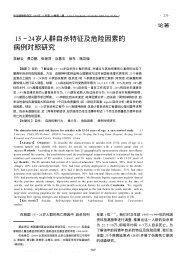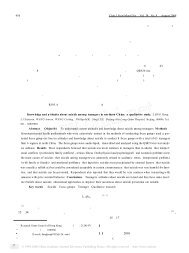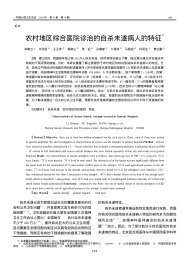Attitudes Toward Suicide Among Chinese People in Hong Kong
Attitudes Toward Suicide Among Chinese People in Hong Kong
Attitudes Toward Suicide Among Chinese People in Hong Kong
Create successful ePaper yourself
Turn your PDF publications into a flip-book with our unique Google optimized e-Paper software.
568 <strong>Attitudes</strong> <strong>Toward</strong> <strong>Suicide</strong> <strong>in</strong> <strong>Hong</strong> <strong>Kong</strong><br />
TABLE 1 Endorsement of <strong>Suicide</strong> Under Difficult<br />
Sociodemographic Profile of Respondents<br />
Life Scenarios<br />
Sociodemographic characteristics n % The likelihood of respondents consider<strong>in</strong>g<br />
suicide under hypothetical difficult life<br />
Gender<br />
Male<br />
Female<br />
Age (years)<br />
15–25<br />
26–50<br />
51–75<br />
Marital Status<br />
S<strong>in</strong>gle<br />
667<br />
530<br />
503<br />
410<br />
229<br />
636<br />
55.7<br />
44.3<br />
44<br />
35.9<br />
20.1<br />
52.7<br />
scenarios is shown <strong>in</strong> Table 4. There were six<br />
scenarios with mean scores higher than 2<br />
(probably not consider suicide). In descend<strong>in</strong>g<br />
order of the mean score, they were, namely,<br />
“be<strong>in</strong>g term<strong>in</strong>ally ill,” “hav<strong>in</strong>g a chronic psychiatric<br />
illness,” “be<strong>in</strong>g severely depressed,”<br />
“be<strong>in</strong>g a burden to others and feel<strong>in</strong>g hopeless<br />
about the future,” “be<strong>in</strong>g heavily <strong>in</strong>-<br />
Married 570 47.3 debted because of gambl<strong>in</strong>g,” and “not hav-<br />
Education <strong>in</strong>g anyone to provide f<strong>in</strong>ancial or emotional<br />
Primary or below 166 14.0 support <strong>in</strong> old age.” The six mean scores of<br />
Middle School 233 19.7 the same six scenarios were also significantly<br />
High School<br />
Tertiary or Above<br />
Religion<br />
Christianity<br />
Buddhism or Taoism<br />
Others<br />
None<br />
Employment<br />
254<br />
529<br />
192<br />
217<br />
12<br />
805<br />
21.5<br />
44.8<br />
15.7<br />
17.7<br />
1.0<br />
65.7<br />
lower than 3 (probably consider suicide). This<br />
suggests that respondents’ general <strong>in</strong>cl<strong>in</strong>ation<br />
toward suicide <strong>in</strong> the hypothetical scenarios<br />
is not strong. Multivariate logistic regression<br />
on how sociodemographic variables relate to<br />
consideration of suicide <strong>in</strong> hypothetical scenarios<br />
shows that females (OR = 1.4) were<br />
Work<strong>in</strong>g 736 62.1 significantly more likely than males to con-<br />
Nonwork<strong>in</strong>g 40 3.3 sider suicide. Older respondents (51–75 years)<br />
Students 410 34.6 were more likely to consider suicide (OR =<br />
Occupation<br />
Professional<br />
Adm<strong>in</strong>istrative<br />
Skilled<br />
Nonskilled<br />
Personal monthly <strong>in</strong>come<br />
Less than US$641<br />
US$641–US$1,282<br />
US$1,283 or above<br />
134<br />
190<br />
112<br />
600<br />
576<br />
396<br />
250<br />
12.9<br />
18.3<br />
10.8<br />
57.9<br />
47.1<br />
32.4<br />
20.5<br />
2.3) than the youngest age group (below 25<br />
years). Respondents who had suicidal ideation<br />
(OR=2.3) were also more likely to consider<br />
suicide.<br />
The likelihood of consider<strong>in</strong>g suicide<br />
<strong>in</strong> hypothetical scenarios was compared to<br />
respondents’ report of suicide ideation and<br />
attempt. <strong>Among</strong> the respondents who reported<br />
that they would be “very likely to consider”<br />
or would “def<strong>in</strong>itely consider” suicide<br />
less negative appraisal of suicide than fe-<br />
males, they showed less sympathy toward suicidal<br />
people and less agreement that suicide<br />
had <strong>in</strong>strumental functions such as revenge.<br />
They were also less likely to differentiate sui-<br />
cide attempt from completed suicide. Nega-<br />
tive appraisal and fatalistic view of suicide decreased<br />
with age. Respondents who were<br />
<strong>in</strong> at least one hypothetical scenario, a substantial<br />
proportion had thought of suicide<br />
(20.8%) or had attempted suicide before<br />
(3.3%). Those who did not consider suicide<br />
seriously <strong>in</strong> the hypothetical scenarios were<br />
less likely to report suicidal thought (4.7%)<br />
or suicide attempt (1.3%).<br />
married, less educated, work<strong>in</strong>g, or believers<br />
<strong>in</strong> Buddhism or Taoism were less negative<br />
DISCUSSION<br />
and fatalistic about suicide. More educated<br />
respondents and more skilled workers were<br />
Diversity of <strong>Attitudes</strong> <strong>Toward</strong> <strong>Suicide</strong><br />
more likely to disagree that suicide is related The biased sampl<strong>in</strong>g notwithstand<strong>in</strong>g,<br />
to social change.<br />
the present study revealed a diversity of atti-<br />
494
















